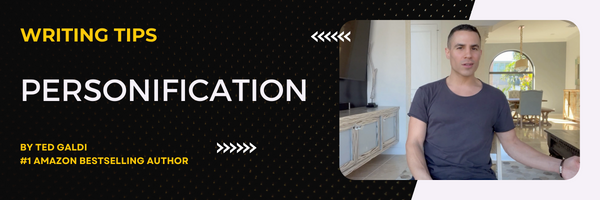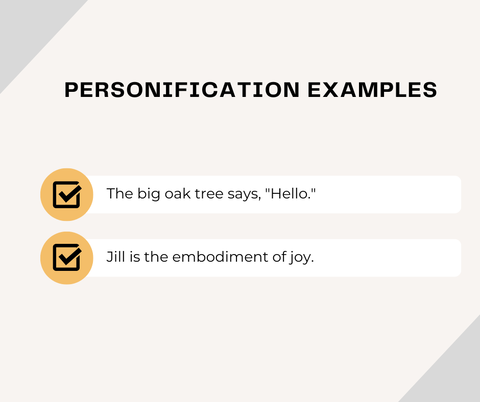Personification Examples [Improve Your Writing]Learn the definition of personification and the different types, see various personification examples, and pick up some tips for adding this literary device to your writing for strong effect. Personification definitionPersonification refers to the depiction of human qualities in non-human items, such as buildings or animals. However, it can also refer to the depiction of a concept, like fear or perseverance, in the form of a human. Personification examplesIn narrative writing, when human characteristics are given to non-human items, writers often explicitly state these instances of personification. However, when humans embody a certain concept, writers often do not explicitly state the connection, but suggest it figuratively. 10 examples of stated personification
10 examples of non-stated, conceptual personification
Tips for adding personification to your writing1. Personifying non-human characters Non-human personification is critical for stories with non-human characters. In a fantasy story, for example, most of the characters might be animals. For an audience to identify with them, they should be given human qualities like the ability to talk. In a science fiction story that takes place in a different galaxy, all the characters might be aliens. Though these aliens may not look like humans, the writer should give them certain human qualities so the audience can identify with them. For instance, although most of these aliens may be seventy feet tall and have IQs of 850, they live in homes with families (just like humans) and bicker with family members (just like humans). 2. Personifying settings Settings are a great place to apply personification to create a human connection. For instance, let's say a character in an adventure story enters a dangerous jungle. A writer can elevate this scene by personifying the jungle. "Human vs. human" conflict is emotionally engaging. And though a jungle isn't a human, if it can feel like one, the conflict can become more vibrant... Ken takes his first step into the Bagana wilderness. The jungle's hot sun stares down at him. He looks for shade, but wherever he goes, the unforgiving sun finds him. When describing settings, as a general guideline, the amount of page space you dedicate to the description should be proportional to how important that setting is in your story. For example, if a character stops at a diner for a quick cup of coffee during a road trip, and that diner never appears in the story again, you shouldn't spend three pages describing the place. However, let's say you're telling a story about a seemingly law-abiding waitress who secretly deals drugs out of the diner where she works. Many of the scenes take place there. Going deep into the description of this diner, applying personification and other writing techniques, would be a good idea. 3. Personifying objects Like a setting, objects in a story can feel more vibrant if personified. Let's look at an example in an action story... Charles knows he's in trouble. He can hear his enemy's footsteps racing toward him from behind. Though Charles lost his gun, an old friend is still hanging around. His set of brass knuckles. While describing objects, follow the same guideline as settings - the amount of page space used to describe an object should be proportional to its importance in the story. A set of brass knuckles that plays a pivotal role in a fight scene could surely have a couple sentences of description, maybe even a couple paragraphs, while a stick of gum a character casually chews on may deserve just a couple words. 4. Personifying concepts When characters in a story represent concepts, the theme of a story can feel more palpable. A theme is the takeaway about life in general an audience would have after finishing a story. Since themes are abstractions about life, they involve concepts. Examples of story themes:
When certain characters in a story embody concepts related to the theme, the conflicts those characters go though can show the depth of the theme, and thus, make it more believable. For an example, let's look at this theme: Unresolved issues from the past can ruin the future. In this story, our main character will be Bill. He used to be a criminal. He went to prison for ten years. When he gets out, he decides to leave his life of crime behind and create a peaceful future for himself in the suburbs. There, he meets Sophia, a kind woman who has never committed a misdemeanor in her life. Bill views her as a potential wife - she represents "the future." A couple months into dating Sophia, Bill gets an unexpected visitor at his doorstep, Allen. Allen was Bill's old criminal associate, who feels he's owed $90,000 from a job they did over a decade ago. Bill doesn't believe Allen's justification, and even if he did, doesn't have $90,000 on hand. Allen, who represents "unresolved issues from the past," keeps antagonizing Bill. Sophia can't help but notice Bill's conflict with this angry stranger. To get revenge on Bill, Allen eventually targets Sophia. In the climax, she escapes death. However, even though Allen is arrested, Sophia has lost interest in marrying Bill. She decides to leave him. This idea of concept representation can be furthered with the development of motifs, which are recurring elements in your story that stand for ideas related to your theme. In the example above, story elements associated with Sophia can help you make points about the future. For instance, she could be renovating her and Bill's house, wanting to put a fresh, modern take on some of the old styles. Allen's appearance in their life causes so much stress Sophia becomes too distracted to continue with the project and puts it on hold. This plot event conceptually conveys the point, "Because of Allen, Sophia and Bill's relationship has stopped moving forward, and is stuck in the past." Want even more writing tips?You might also like my examples of other literary devices, such as alliteration examples, metaphor examples, and symbolism examples.
0 Comments
Leave a Reply. |



 RSS Feed
RSS Feed